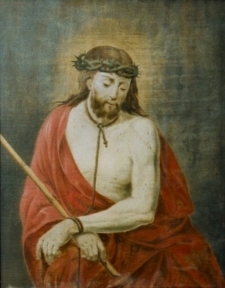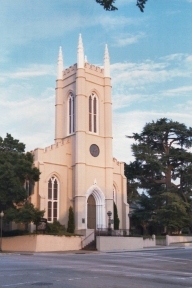| |
St. James’s Episcopal Church
Wilmington, North Carolina
Text and photos by Dan Hardison
From
the days the Spanish roamed the coast, through the fight for
independence from the British, and the dark years of the Civil War, the
port city of Wilmington, North Carolina, has been a vital link to the
sea. And standing at its center has been St. James Episcopal Church.
After a failed attack by the Spanish in 1748, they left behind a heavily
damaged ship. On board the ship was discovered a painting of Christ that
would find a new home in St. James Church.
Wilmington
sits on the bank of the Cape Fear River just fourteen miles from the
Atlantic Ocean and has a long history in shipping. In 1748 three Spanish
ships sailed into the Cape Fear River and attacked the colonial settlement
of Brunswick Town below Wilmington. After four days of fighting, the
Spanish were repelled – leaving behind a badly damaged ship. When the
"Fortuna" was searched, a painting of Christ was found in the captain’s
cabin.
The painting
called Ecce Homo – Latin for behold the man – is a portrayal of Christ
with a crown of thorns. It is a haunting depiction of Christ in a red
robe, with bound hands, and a crown of thorns. The painting has been
attributed to Francisco Pacheco (1564-1654) – a Spanish painter, teacher,
and scholar.
St. James
Parish and its sister church, St. Philips Parish in Brunswick Town, were
established in 1729. Proceeds from the sale of the salvaged goods from the
Fortuna went to the construction of a building for St. James and for St.
Philips. The Francisco Pacheco painting of Christ was given to St. James
in 1751.
The original
building for St. James was completed in 1770. During the Revolutionary
War, British General Cornwallis had his headquarters in a house located
across the street from St. James and the church was used as a hospital and
then a riding school for the British army. In 1839 the old colonial church
was torn down and a new building constructed reusing the old bricks. T.U.
Walter, architect of the U.S. Capitol dome, designed the new church.
After the
fall of Fort Fisher during the Civil War, Wilmington was occupied by Union
troops and St. James was again used as a hospital. Wilmington was the last
remaining supply route for the South and the war would come to an end just
months after its fall.
Silas McBee –
Episcopal educator, writer, and architect – carved an elaborate oak altar
and reredos for St. James in 1892 depicting the Nativity, Crucifixion, and
Resurrection. He also designed the Bishop’s chair and two stained glass
windows for the church including The Resurrection of Christ that is seen
above the reredos.
Through the
years St. James has been expanded, but great care has always been taken to
maintain its original gothic design. The Parish House was built in 1923
and a house next door that was built in 1901 and designed by Henry Bacon,
architect of the Lincoln Memorial, is now used for the church offices.
Behind the
church is the traditional churchyard cemetery where tombstones can be
found from the 1700’s. Over the years St. James has become the resting
place for three Episcopal Bishops. Bishops Robert Strange, Thomas
Atkinson, and Thomas H. Wright are all buried beneath the church.
Today St.
James sits in the heart of the Historic District of Wilmington – three
blocks from the Cape Fear River. It is the oldest church in Wilmington
that is still in continuous use. St. James and Wilmington have a rich
history that has always been entwined. The painting, Ecce Homo, serves as
a link to that history and of its earliest days. |
|

Ecco Homo
By Francisco Pacheco

Altar and Reredos
By
Silas McBee

The Church House

|
|
![]()